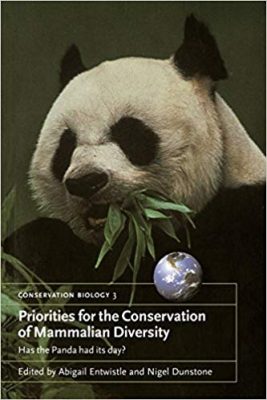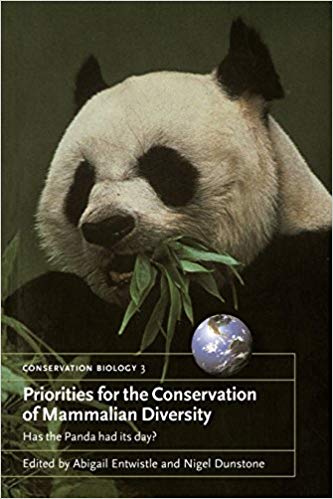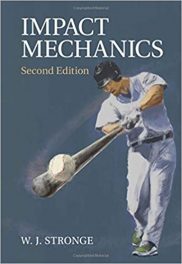 Editors: Abigail Entwistle and Nigel Dunstone
Editors: Abigail Entwistle and Nigel Dunstone
Publisher: Cambridge University Press – 455 pages
Book Review by: Sonu Chandiram
About a quarter of all species of mammals are now threatened with extinction based on recent research, the editors of this book point out.
What are the justifications for mammal conservation? The editors and chapter authors provide the reasons. What approaches to conservation, and what techniques based on experience, are the most effective? The results of various programs are presented in this book.
Which groups of mammals take priority over others in conservation efforts? Which are the ‘flagship species’? How should funds be allocated to get maximum results? The answers to these questions and more are provided in this important book on mammalian conservation. .
Forty-one specialists in areas such as the biological sciences, wildlife conservation, and zoology from all over the United Kingdom and six other countries – China, Denmark, Kenya, South Africa, Switzerland, and the United States – authored the 21 chapters of this book focused on conservation of mammals.
We name the chapters below to provide you a broad overview of the contents of this work:
- Mammal Conservation: Current Contexts and Opportunities
- Part I – Justifying the Conservation of Mammals
- Ecological Roles of Mammals: The Case of Seed Dispersal
- Patterns and Processes in Contemporary Mammalian Extinction
- Charismatic Megafauna as ‘Flagship Species’
- Part II – Setting Priorities for Mammalian Conservation
- Assessing Large ‘Flagship Species’ For Representing the Diversity of Sub-Saharan Mammals
- Abundance / Mass Relationships As a Quantified Basis for Establishing Mammalian Conservation Priorities
- Small Mammals and the Conservation Agenda
- Rare Mammals: Research and Realpolitik: Priorities for Biodiversity and Ecology?
- Part III – Conservation Approaches for Mammalian Species and Diversity
- Does Legislation Conserve and Does Research Drive Policy?
- British Mammals: Is There a Radical Future?
- Conservation of Large Mammals in Africa: What Lessons and Challenges for the Future?
- Which Mammals Benefit from Protection in East Africa?
- The Role of Trans-frontier Conservation Areas in Southern Africa in the Conservation of Mammalian Biodiversity
- Tourism and Protected Areas – Distorting Conservation Priorities Towards Charismatic Megafauna?
- Integrating Hunting and Protected Areas in the Amazon
- Priorities for Captive Breeding – Which Mammals Should Board the Ark?
- A Recipe for Species Conservation: Multidisciplinary Ingredients
- What Has the Panda Taught Us?
- Never Say Die: Fighting Species Extinction
- Practical Approaches for Including Mammals in Biodiversity Conservation
- Future Priorities for Mammalian Conservation
Two organizations based in Britain – Fauna and Flora International established in 1903, and The Mammal Society with a history of conservation for over 50 years – have been involved in the protection of mammals all over the world for a long periods of time.
In 1997 these two bodies organized and held a symposium that demonstrated that there was a clear and strong interest in conservation, based on a full auditorium of attendees, a wide range of opinions expressed, and significant media coverage.
A large number of suggestions were expressed and gathered in that conference on how to advance the mammal conservation movement forward. This book is a compilation and discussion of ideas received from participants that large event. Also included in this book is data on research work done since 1997 on various aspects of conservation of mammals.
This book therefore is significant not only based on the impact of that 1997 event, but also because of the valuable contributions to its content from various specialists on the subject from around the world. I highly commend the editors and authors involved in this laudable effort.
Editors:
Abigail Entwistle is Senior Scientist at Fauna and Flora International, where she has worked on a broad range of conservation issues from biological surveys to the development of national biodiversity strategies and action plans. Her particular interest is in the integration of conservation biology research into policy development and project management.
Nigel Dunstone is a Lecturer in Zoology at the Centre for Tropical Biology in the Department of Biological Sciences at the University of Durham. He is a member of the Cat Specialist Group of the IUCN Species Survival Commission, and a consultant on the impact of introduced species of mammals and ecotourism development. He is author of The Mink (1993), and co-editor of Mammals to Predators (1993) with M.L. Gorman, The Exploitation of Mammal Populations (1996) with V.J. Taylor, and Behavior and Ecology of Riparian Mammals (1999) with M.L. Gorman.







